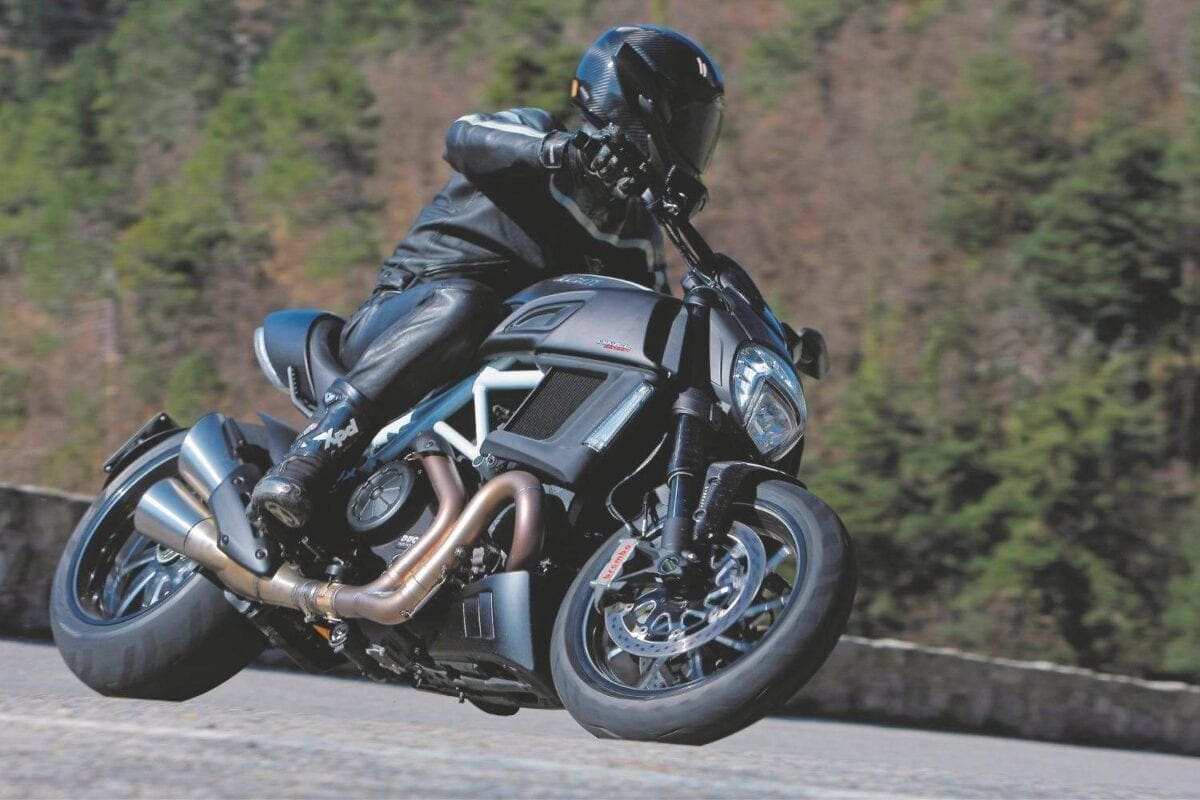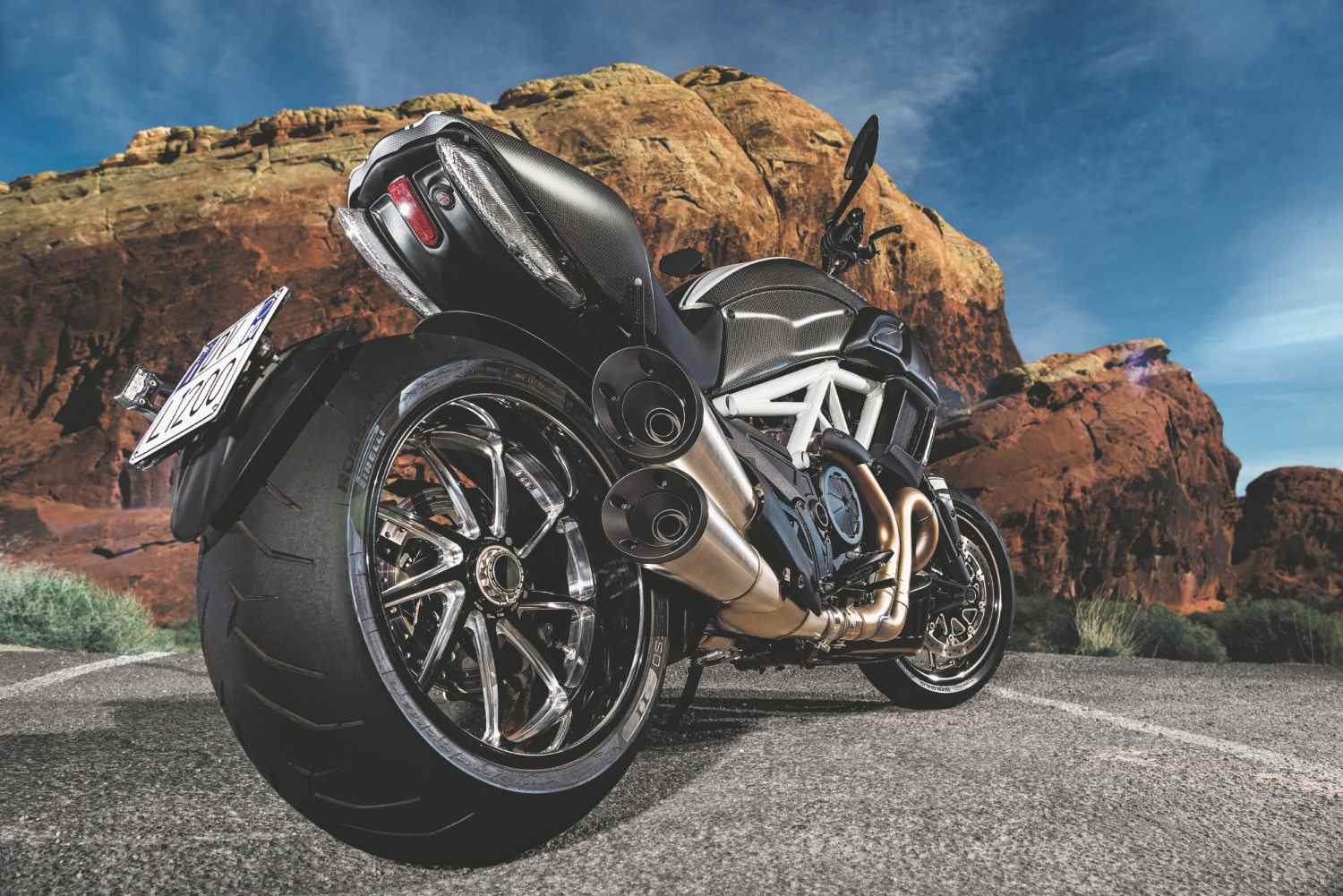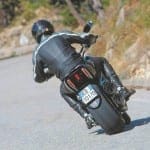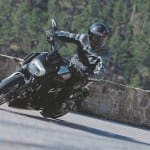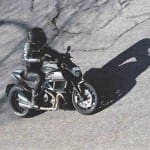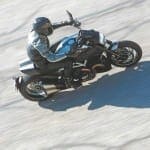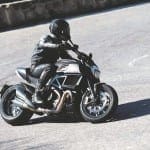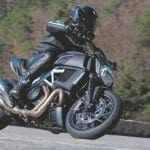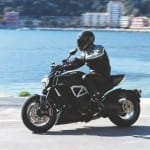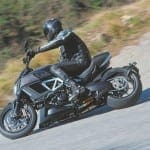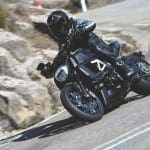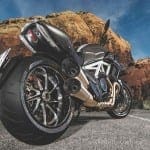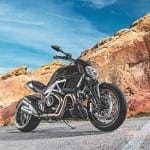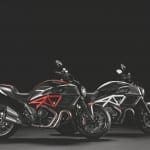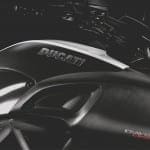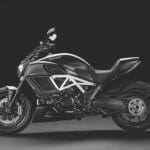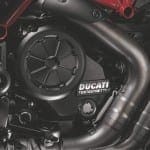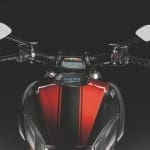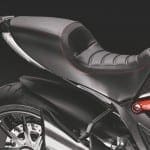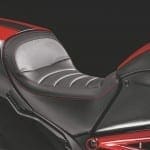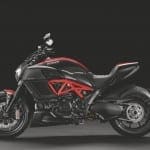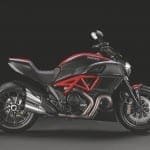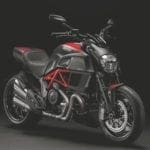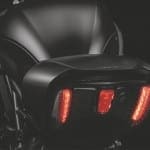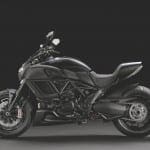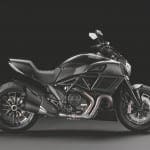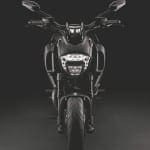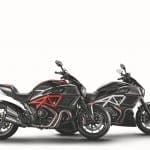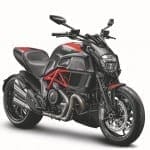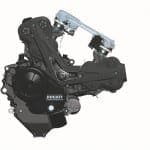£16,995 | 1198cc, liquid-cooled, dohc 8-valve 90-degree desmo V-twin | 160bhp @ 9250rpm | 96.2lb-ft @ 8000rpm
Enjoy everything More Bikes by reading the monthly newspaper, Read FREE Online.
Tested by Roland Brown. Motorcycle Journalist and former international racer, Roland Brown is one of the world’s most respected bike testers. Subscribe to his fantastic YouTube channel here.
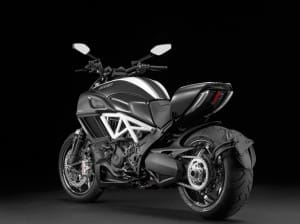 Very few bikes are so different or outstanding that they have no close rivals, but that can definitely be said of the Diavel. The uniquely shaped power cruiser caused controversy before its launch three years ago, not least from hardcore Ducati fans. But the powerful, light, improbably sweet-handling V-twin blew away almost everyone who rode it by being hugely entertaining on city streets and twisty roads alike.
Very few bikes are so different or outstanding that they have no close rivals, but that can definitely be said of the Diavel. The uniquely shaped power cruiser caused controversy before its launch three years ago, not least from hardcore Ducati fans. But the powerful, light, improbably sweet-handling V-twin blew away almost everyone who rode it by being hugely entertaining on city streets and twisty roads alike.
Hence Ducati’s choice of Monaco as the launch venue for this follow-up model. The tiny and affluent Mediterranean principality’s crowded roads suit a cruiser with presence, but nearby are hairpin-strewn Alpine roads just built for a sports bike. This updated Diavel promised to be at home in both situations. Ducati haven’t made major changes, because they didn’t need to. But they’ve given the beefy V-twin a revamp that is intended to enhance its character and add to its low-speed and long-distance ability.
Tell Me About the Engine
This is the most significant change, although the basic format of 1198cc, dohc eight-valve, liquid-cooled V-twin is retained. The new Diavel gets Ducati’s Testastretta 11 degree DS unit, the latter initials standing for its Dual Spark plugs per cylinder layout, as used by the Multistrada and Monster 1200.
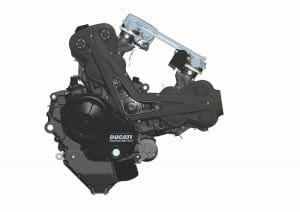 The Diavel’s maximum output of 160bhp at 9250rpm is unchanged. Peak torque is slightly increased, to 196.2 lb-ft, and the curve shows a more noticeable boost at lower revs. On a more down-to-earth note, major service intervals are extended to 18,000 miles, so many owners will never need to get their desmodromic valvegear checked.
The Diavel’s maximum output of 160bhp at 9250rpm is unchanged. Peak torque is slightly increased, to 196.2 lb-ft, and the curve shows a more noticeable boost at lower revs. On a more down-to-earth note, major service intervals are extended to 18,000 miles, so many owners will never need to get their desmodromic valvegear checked.
As before, the motor comes with plenty of typical Ducati sophistication. There’s hands-free ignition, so you can leave the key in your pocket. There’s ride-by-wire throttle control and three riding modes: Sport and Touring, which deliver the full 160 horses with differing throttle response, and Urban, whose softer delivery hits a limit at 100bhp.
What’s the Chassis Like?
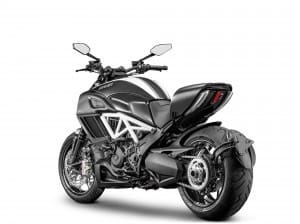 The Diavel’s a traditional Ducati with a conventional tubular steel frame and aluminium single-sided swing-arm, rather than having subframes bolted to a stressed-member engine like the Panigale and Monster 1200. But it’s not remotely traditional in holding its forks at a kicked-out 28 degrees, or having a train-like wheelbase of 1590mm. Let alone having a humungous, 240-section rear tyre on an eight-inch rim.
The Diavel’s a traditional Ducati with a conventional tubular steel frame and aluminium single-sided swing-arm, rather than having subframes bolted to a stressed-member engine like the Panigale and Monster 1200. But it’s not remotely traditional in holding its forks at a kicked-out 28 degrees, or having a train-like wheelbase of 1590mm. Let alone having a humungous, 240-section rear tyre on an eight-inch rim.
This might be basically a cruiser but it’s still very much a Ducati, complete with high quality parts. The front forks are beefy 50mm upside-down Marzocchi units with DLC low-friction coating, not only multi-adjustable but with neat plastic knobs so you don’t need a screwdriver. The rear shock is a similarly adjustable Sachs unit with a remote preload knob for easy twiddling.
Brakes and wheels are well up to standard too. Brembo’s four-piston radial Monobloc calipers bite 320mm discs up front, aided by Bosch ABS. Tyres are Pirelli’s Diablo Rosso II, on 17-inch rims; in the case of the higher spec Diavel Carbon, these are forged Marchesinis that save a total of 2.5kg of weight over the standard cast items.
Should I Buy One?
If you’re a tax exile with an apartment in Monte Carlo, definitely. For anyone else, assuming you’ve got the necessary £13,995 for the basic Diavel, it depends whether you want a bike with the looks of a cruiser (sort of) and the performance of a top super-naked. Bikes like Harley’s V-Rod Muscle or Yamaha’s V-Max have some of the same appeal but are heavier and less agile than the 210kg Diavel.
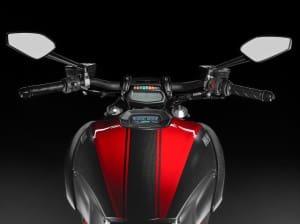 If you’re considering the Ducati you’ll need to decide whether to splash out on the Diavel Carbon, as tested on the launch. This costs £16,995 and has carbon-fibre tank cover, front mudguard and seat unit, plus the aforementioned forged Marchesinis. It also has a red or white frame and tank-top, instead of the standard model’s black, plus stainless steel silencers. Vital bits including engine and suspension are identical, so the three grand premium seems slightly steep.
If you’re considering the Ducati you’ll need to decide whether to splash out on the Diavel Carbon, as tested on the launch. This costs £16,995 and has carbon-fibre tank cover, front mudguard and seat unit, plus the aforementioned forged Marchesinis. It also has a red or white frame and tank-top, instead of the standard model’s black, plus stainless steel silencers. Vital bits including engine and suspension are identical, so the three grand premium seems slightly steep.
So What’s it Like to Ride?
An absolute riot, whether you’re posing on city streets with the occasional blast away from the lights to get the adrenaline flowing, or carving up and down Alpine roads at a rate that would see plenty of sports bikes shrinking in the reasonably useful mirrors. We saw both sides on the launch, which began with an early-evening cruise through Monte Carlo, taking in some of the Formula One circuit and winding past landmarks including the casino and marina.
The Diavel was brilliant for the job. It has the style and presence to make you feel right at home in that environment, for one thing. The hands-free ignition, activated by the key that can be left in your pocket, is a neat touch. And the big, brash Ducati is improbably manoeuvrable and comfortable in town with its upright riding position, low and well-padded seat (now with trendy ribbed cover) and effortlessly light controls.
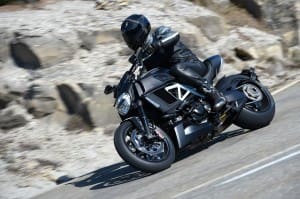 It also has a satisfying character; firing up with a throaty bark from those silencers behind your right boot, and rumbling along with a pleasingly smooth yet involving V-twin feel. Throttle response in all modes was crisp yet controllable, so on dry roads there was no real need for Urban even in town, apart from adjusting the traction control setting (to the fifth of eight levels by default, though it’s programmable). The Ducati still responded eagerly, hurtling forward instantly any time I spotted a gap in the traffic.
It also has a satisfying character; firing up with a throaty bark from those silencers behind your right boot, and rumbling along with a pleasingly smooth yet involving V-twin feel. Throttle response in all modes was crisp yet controllable, so on dry roads there was no real need for Urban even in town, apart from adjusting the traction control setting (to the fifth of eight levels by default, though it’s programmable). The Ducati still responded eagerly, hurtling forward instantly any time I spotted a gap in the traffic.
The only disappointing aspect of the powerplant was the gearbox, which was slick on the move but occasionally struggled to find neutral at a standstill. Strange, because I don’t recall that fault with other Ducatis (though the transmission’s lack of miles might not have helped). There was also a slight glitch with the sidestand, which occasionally didn’t retract properly, so needed a second flick before the engine would start. By coincidence the two-level instrument panel has gained a sidestand warning light, surely redundant if the cut-out works, along with a more useful digital fuel gauge in the tank-top display.
Ragging round Monte Carlo was amusing, but it was when we left town for the nearby mountain roads that the Diavel revealed its full brilliance. I won’t claim to have noticed any additional performance over the old model. What’s for sure though is that it was fantastic fun to crack open the throttle exiting a bend at maybe 6000rpm — where Ducati say torque is increased by almost five per cent — and grip that raised one-piece handlebar tight as a torrent of grunt sent the bike charging hard enough to make me glad of the seat’s kicked-up rear section.
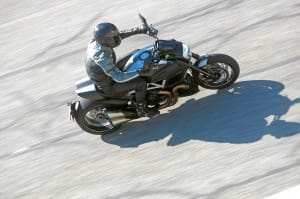 The acceleration was mind-blowing, made stronger still by the Diavel’s ability to keep its front wheel down while its fat back tyre was finding enough traction to spin the Earth a bit faster. And the Diavel was perfectly happy on the few sections where we held a steadier speed. The reshaped handlebar riser didn’t give much wind protection but in conjunction with the headlamp surround it was better than nothing.
The acceleration was mind-blowing, made stronger still by the Diavel’s ability to keep its front wheel down while its fat back tyre was finding enough traction to spin the Earth a bit faster. And the Diavel was perfectly happy on the few sections where we held a steadier speed. The reshaped handlebar riser didn’t give much wind protection but in conjunction with the headlamp surround it was better than nothing.
The Diavel is generally more versatile than you might imagine, though the sometimes thirsty engine (sub-30mpg when thrashed up an Alp) limits the 17-litre tank’s typical range to not much over 120 miles. Ducati have dropped last year’s Diavel Strada but you can still get extra touring ability via that model’s screen and ABS/nylon panniers. Naturally the accessories catalogue features countless carbon and alloy bits too.
The Ducati’s relatively long wheelbase was also helpful under braking, where those Brembo Monoblocs could utilise their phenomenal bite without causing the rear end to lift as readily as normal, allowing some assistance from the rear disc. The ABS activated into a couple of bumpy downhill hairpins, but generally worked superbly well too.
 As before, the Diavel’s most impressive feature was the way that this long, laid-back machine flicked into turns and carved through them. Inevitably it was a bit cumbersome through the tightest of hairpins, but always got round fine (and even had enough steering lock for easy U-turns). In most turns the Ducati responded with such ease and precision that it felt like a good super-naked bike. There was plenty of ground clearance, too, and the Diablo Rosso IIs had enough grip to make the most of it.
As before, the Diavel’s most impressive feature was the way that this long, laid-back machine flicked into turns and carved through them. Inevitably it was a bit cumbersome through the tightest of hairpins, but always got round fine (and even had enough steering lock for easy U-turns). In most turns the Ducati responded with such ease and precision that it felt like a good super-naked bike. There was plenty of ground clearance, too, and the Diablo Rosso IIs had enough grip to make the most of it.
Ride quality was respectable, despite the forks’ angle and the relatively stingy 120mm of travel at each end. The hand-adjustable fork damping screws and shock preload knob are useful, the latter especially so if you’re planning on carrying a pillion. The seat is slightly larger, and quite generously padded. Another neat touch carried over from the original bike is the way the grabrail and rear footrests can quickly be tucked out of sight when not required.
In a way that’s the Diavel all over. It doesn’t just look striking, it’s bursting with elegant design, whether in details like the grab-rail or major aspects such as handling and braking. A bike with such a strong character will never be popular with every rider, but you’d need a heart of stone not to get off the Diavel with a big smile on your face.
Price: £16,995 [£13,995]
Engine: 1198cc, liquid-cooled, dohc 8-valve 90-degree desmo V-twin
Power: 160bhp (119kW) @ 9250rpm
Torque: 96.2lb-ft (130.5N.m) @ 8000rpm
Kerb weight: 234kg [239kg]
Seat height: 770mm
Tank size: 17 litres
More photos…
Advert
Enjoy everything More Bikes by reading the MoreBikes monthly newspaper. Click here to subscribe, or Read FREE Online.


